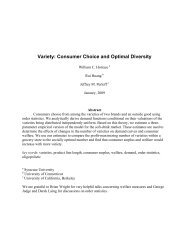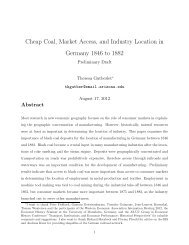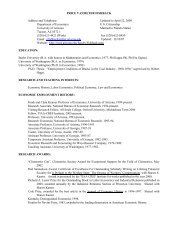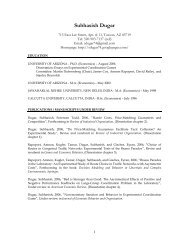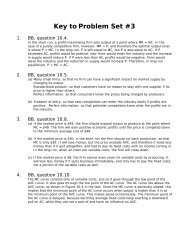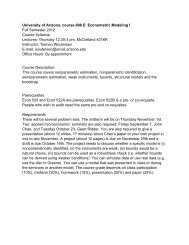A Dynamic Model of Demand for Houses and Neighborhoods
A Dynamic Model of Demand for Houses and Neighborhoods
A Dynamic Model of Demand for Houses and Neighborhoods
You also want an ePaper? Increase the reach of your titles
YUMPU automatically turns print PDFs into web optimized ePapers that Google loves.
Figure 2: Percentage White<br />
Finally, we illustrate the time series properties the amenities we consider with a simple<br />
statistical analysis. Table 4 reports the results <strong>of</strong> three regressions where each variable in period<br />
t + 1 is regressed on its value in period t, along with a vector <strong>of</strong> neighborhood dummies that are<br />
removed by demeaning the data. The AR(1) coefficient describes the extent to which shocks to<br />
the amenity persist over time. For instance, the coefficient on lagged ground-level ozone (-0.057)<br />
reveals very little correlation from year to year (<strong>and</strong> what correlation we do find is negative).<br />
Looking at the R 2 <strong>for</strong> this regression, lagged ozone explains very little <strong>of</strong> the variation in current<br />
ozone. Instead, ozone tends to revert to its neighborhood-specific mean after a high or low<br />
year. In stark contrast, the coefficient on lagged percentage white (1.026) suggests very strong<br />
persistence in any shocks from year to year. With a coefficient <strong>of</strong> 0.718, shocks to violent crime<br />
show some tendency to persist over time, but that tendency is not as great as in the case <strong>of</strong><br />
neighborhood racial composition.<br />
We close this brief data section by providing the reader with a sense <strong>of</strong> the variation in the<br />
evolution <strong>of</strong> prices across regions <strong>of</strong> the Bay Area. The precision <strong>of</strong> our model depends critically<br />
on the fact that rates <strong>of</strong> house price appreciation are not uni<strong>for</strong>m across neighborhoods. Figure<br />
1 reports real house price appreciation by PUMA from 1990 to 2004. The estimated price levels<br />
are derived separately <strong>for</strong> each PUMA using a repeat sales analysis in which the log <strong>of</strong> the sales<br />
12



